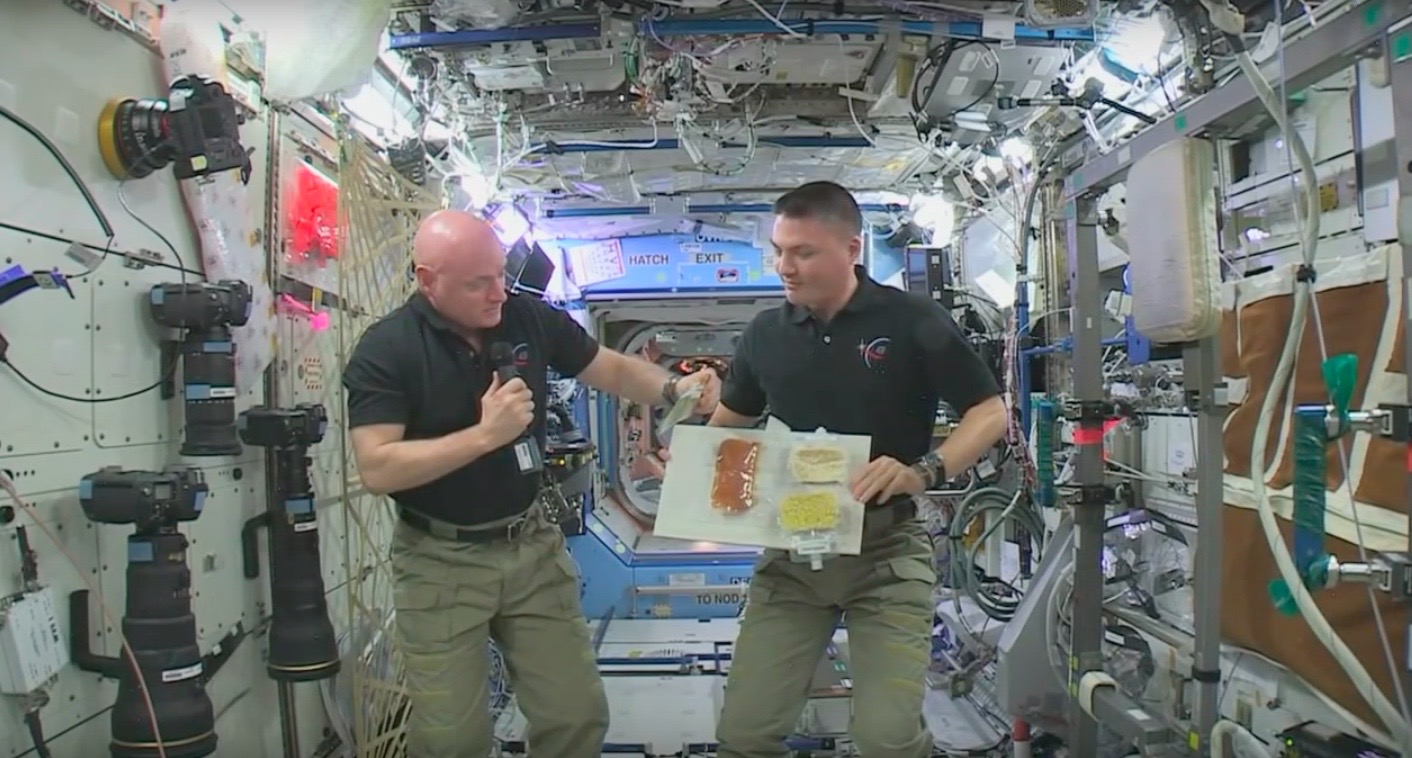


As people on Earth prepared to celebrate Thanksgiving, astronauts aboard the International Space Station marked the holiday in a unique way. The team of astronauts, including American, Japanese, and Russian crew members, shared their favorite dishes and traditions, while floating 250 miles above the Earth. The special Thanksgiving celebration in space showcased the international collaboration and spirit of unity among the crew members.
As people on Earth prepared to celebrate Thanksgiving, astronauts aboard the International Space Station marked the holiday in a unique way. The team of astronauts, including American, Japanese, and Russian crew members, shared their favorite dishes and traditions, while floating 250 miles above the Earth.
The special Thanksgiving celebration in space showcased the international collaboration and spirit of unity among the crew members. It also highlighted the challenges and triumphs of living and working in space.
Thanksgiving is a holiday that is celebrated in the United States, Canada, and other countries. It is a time to give thanks for the harvest and to spend time with family and friends.
The first Thanksgiving was celebrated in 1621 by the Pilgrims and the Wampanoag Indians. The Pilgrims were a group of English settlers who had come to America in search of religious freedom. The Wampanoag Indians were a Native American tribe who lived in the area that is now Massachusetts.
Thanksgiving dinner is typically a large meal that includes turkey, stuffing, mashed potatoes, cranberry sauce, and pumpkin pie. In space, the astronauts had to make do with freeze-dried food and other non-perishable items.
Each of the astronauts on the International Space Station shared their favorite Thanksgiving traditions.
Celebrating Thanksgiving in space is not without its challenges. The astronauts have to deal with the following:
Despite the challenges, the astronauts on the International Space Station have found ways to celebrate Thanksgiving in a meaningful way. They have shared their favorite dishes and traditions, and they have spent time together giving thanks for their many blessings.
The astronauts' Thanksgiving celebration is a reminder of the human spirit's ability to overcome challenges and find joy in even the most difficult circumstances. It is also a reminder of the importance of international collaboration and cooperation.
1. What is the International Space Station?
The International Space Station is a space station that is in orbit around the Earth. It is a joint project of five space agencies: NASA (United States), Roscosmos (Russia), JAXA (Japan), ESA (Europe), and CSA (Canada).
2. How long have astronauts been living on the International Space Station?
Astronauts have been living on the International Space Station since 2000.
3. What is the purpose of the International Space Station?
The International Space Station is used for a variety of research and educational purposes. Astronauts on the ISS conduct experiments in fields such as biology, chemistry, and physics. They also study the effects of microgravity on the human body.
4. How many astronauts are currently on the International Space Station?
There are currently three astronauts on the International Space Station: Christina Koch (USA), Anatoly Ivanishin (Russia), and Soichi Noguchi (Japan).
5. What is Thanksgiving?
Thanksgiving is a holiday that is celebrated in the United States, Canada, and other countries. It is a time to give thanks for the harvest and to spend time with family and friends.

Every year, India celebrates the birth anniversary of the renowned physicist CV Raman, who is known for his groundbreaking work on light scattering and the Raman Effect. Despite receiving numerous offers to work in Western labs after winning the Nobel Prize in Physics, Raman remained committed to his belief in fostering a strong scientific culture in India and mentoring future scientists. His discovery of the Raman Effect continues to be relevant and widely used in various fields today, serving as a testament to the quantum nature of light and the energy levels in molecules.

As meditation gains popularity as a mental well-being tool, concerns about potential side effects have emerged. A recent study by a team of researchers from the University of Melbourne delved into the prevalence of adverse experiences among meditators in the United States. By recruiting nearly 900 adults from various meditation skill levels, the study aimed to provide more accurate estimates of how common these side effects are and what factors may contribute to experiencing them. The findings highlight the need for clearer reporting standards in future research on meditation.

Prime Minister Narendra Modi launched a groundbreaking research, development and innovation scheme that will provide a boost to the flourishing ecosystem of innovation in India. In his address at the Emerging Science, Technology and Innovation Conclave, PM Modi highlighted the crucial role of science and technology in driving transformation and emphasized on India's significant progress in the field. He also acknowledged the remarkable achievement of India's women's cricket team and expressed confidence that their success would inspire the country's youth. Attendees included renowned scientists, innovators, and distinguished guests from both India and abroad.

Indian Prime Minister Narendra Modi inaugurated the Emerging Science and Technology Innovation Conclave (ESTIC) 2025 and launched the Rs 1 lakh crore Research Development and Innovation (RDI) Scheme Fund. The scheme aims to strengthen the private sector-driven research and innovation ecosystem in the country and has a total outlay of Rs 1 lakh crore over 6 years. ESTIC 2025, gathering over 3,000 participants, focuses on 11 critical thematic areas including Artificial Intelligence, Quantum Science and Technology, and Space Technologies, providing opportunities for collaboration and reinforcing India’s science and technology ecosystem.

In this edition of Health360, a renewed debate over the alleged link between vaccines and autism is sparked by tech mogul Sridhar Vembu's endorsement of a questionable study. Despite reassurances from the medical community backed by data from the WHO, doubts continue to persist, leading to potential harm to public health. The program also delves into the alarming rise in back pain cases in India and explores new treatments.

In an effort to fight the ongoing air pollution crisis, Delhi conducted its first-ever official cloud seeding operation led by IIT Kanpur. The operation involved a small aircraft dispersing specially designed chemical flares into the atmosphere to create rain. While experts say rainfall could occur within 15 minutes to 4 hours, the actual timeframe depends on various factors such as wind direction and moisture content. If successful, the government plans to continue the operation in the coming days.

In the quest for stronger, luscious hair, we often overlook the importance of nurturing the roots. Fortunately, Ayurveda has long stressed the significance of this practice, which has now been backed by modern science. Studies have shown that herbs like Bhringraj and Amla can activate hair follicles, promoting new growth and delaying greying. Fenugreek, Neem, Hibiscus, and Ashwagandha are also found to be beneficial in strengthening and nourishing the scalp, resulting in thicker and healthier hair.

A college student shares her personal journey of becoming a vegetarian, despite facing challenges and health concerns. She then delves into an ethics class she took, where the concept of marginal cases were discussed. Following an article by philosophy professor Alastair Norcross, she concludes that even though individual action may seem insignificant, refusing to consume factory-farmed meat holds moral significance due to the potential to prevent immense suffering for animals.

On October 24, the global community commemorates World Polio Day to honor the legacy of Dr. Jonas Salk and the efforts of countless individuals and organizations in the fight against polio. This highly contagious and potentially deadly disease, once a widespread epidemic, is now largely preventable thanks to the development of a life-saving vaccine. India's successful eradication of polio serves as a testament to the importance of strong vaccination programs and collaborations in public health initiatives.

As winter arrives in India, so does the hazardous air pollution. Delhi NCR's AQI has already crossed the 400 mark, making it crucial to invest in air purifiers, especially after Diwali. Dyson, Qubo, HomePure, and Philips have launched high-quality air purifiers with advanced features to tackle different types of pollutants and create cleaner indoor air. With prices ranging from Rs 5,000 to Rs 1 lakh, these purifiers are a practical and timely purchase for a healthier living.